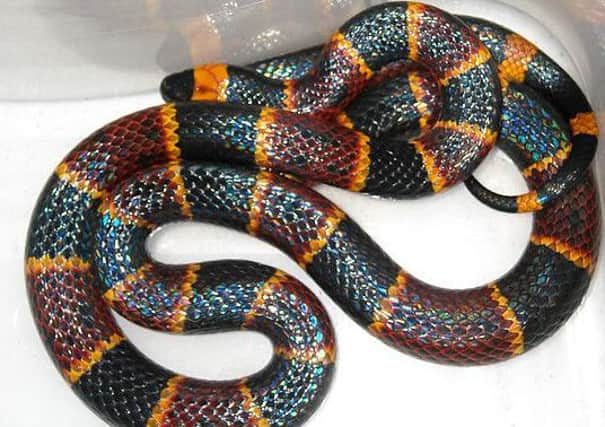Natural born killers: The venomous facts about snakes being kept in Portsmouth


The different snakes being kept under licence in private premises in Portsmouth are revealed today in a Freedom of Information answer from the city council.
Here are the basic facts about each variety.
Coral Snake
“Red on yellow, kill a fellow” and “Red on black, friend of Jack” are a couple of folk rhymes to distinguish between the venomous coral snake and similar non-venomous snakes. Coral snakes are slender and small, typically between 18 and 20 inches long, vibrantly coloured - and highly venomous. They spend most of their time underground in places such as holes dug by other animals. They can also be found in hidden places such as underneath rotting leaves or in tree stumps. When coral snakes are provoked, they will sometimes make a popping sound to startle the threat. Humans are usually bitten when trying to pick up a coral snake. Its neurotoxic venom causes rapid paralysis and respiratory failure in its prey; however it can take many hours for symptoms to appear in humans. Symptoms include slurred speech, double vision and muscular paralysis.
Cobra
Advertisement
Hide AdAdvertisement
Hide AdCobras are among the most iconic snakes on Earth. Their elegant stance and venomous bite have made them both respected and feared. Cobras are a type of poisonous snake with hollow fangs fixed to the top jaw at the front of the mouth. These snakes cannot hold their fangs down on prey so they inject venom though their fangs. The most well known physical characteristic is cobras is the hood. Cobras typically live in hot, tropical areas but are also found in grasslands, forests and farming areas. Cobras signal a willingness to attack by hooding, hissing and raising the upper portion of their bodies. Cobra bites can be fatal, especially if left untreated. Like coral snakes, cobras have potent neurotoxic venom which acts on the nervous system. Symptoms can include problems with vision, difficulty swallowing, muscle weakness, difficulty breathing, vomiting and abdominal pain.
Vipers
All vipers are venomous and have long, hinged fangs. Vipers range widely in size, though are generally stocky with short tails. Almost all vipers have a distinctive triangular head. The head shape is due to the placement of their large venom glands in the mouth. The severity of a viper bite depends on the species but vipers in general tend to have enzymatic venom that affects general tissues. It causes intense swelling, pain and necrosis, which is cell death and decay. All viper bites should be treated seriously and medical attention sought without delay.
Puff Adders
Puff adders are members of the viper family. They average about three feet in length and have stout bodies. They have brown, grey and black markings with a distinctive chevron pattern which makes for effective camouflage. Puff adders have cytotoxic venom, which means it destroys tissues in a process called necrosis and most fatalities occur not from the severity of the venom but from poor medical care.
Rattlesnake
Rattlesnake can range from one to eight feet, they are thick-bodied snakes with keeled (ridged) scales in a variety of colours and patterns. Most species are patterned with dark diamonds, rhombuses or hexagons on a lighter background. Most people bitten by rattle snakes have accidentally stepped on them. Rattlesnake bites can be dangerous but are very rarely fatal to humans/ Their venom is extremely potent. Symptoms include temporary and/or permanent tissue and muscle damage. loss of extremity depending on the location of the bite, internal bleeding and extreme pain around the injection area. Some rattlesnake species have venom that contains neurotoxins - those symptoms include problems with vision, difficulty swallowing and talking and respiratory failure.